
| The 1700s | ||||||||||||||||||
1768–1770 |
THE FIRST CIRCUS! Sergeant-Major Philip Astley |
Philip Astley rose through the British ranks during the Seven Years War. He was known as a humane, skillful equestrian instructor.
|
||||||||||||||||
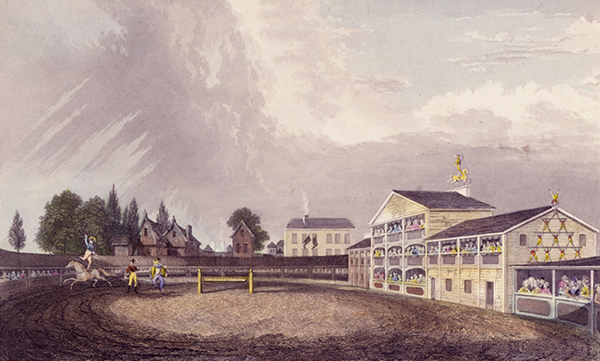 The arena had bleachers surrounding a ring, a "circle" or "circus," Latin for any circular area. (Like Piccadilly Circus.)
The arena had bleachers surrounding a ring, a "circle" or "circus," Latin for any circular area. (Like Piccadilly Circus.)
In 1770 he expanded the arena with spectator boxes and brought in large crowds in the afternoons to see his trick riding.
|
||||||||||||||||||
|
|
||||||||||||||||||
1760s |
First circus clown
|
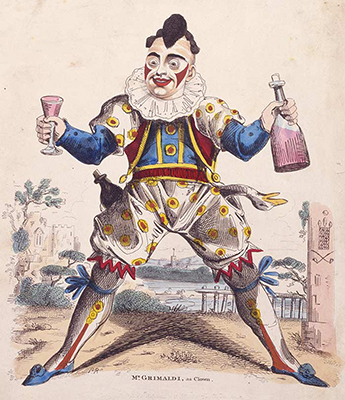 Joe Grimaldi, a spirited cockney, was said to be the first true circus clown. He had a grotesque costume and chalked face. He started out playing a monkey onstage (with his father). Joe Grimaldi, a spirited cockney, was said to be the first true circus clown. He had a grotesque costume and chalked face. He started out playing a monkey onstage (with his father). |
||||||||||||||||
1776 |
Declaration of Independence |
|||||||||||||||||
1779 |
Ring standard size of 42' set |
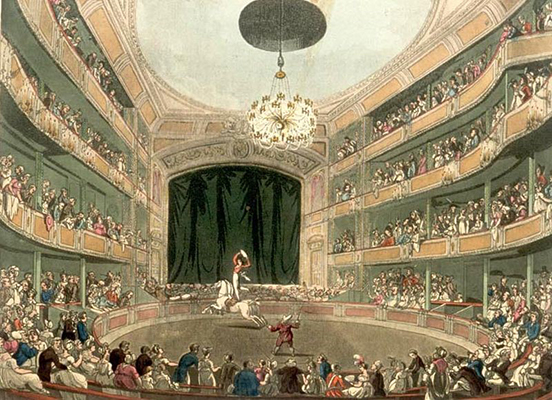 Astley rebuilt his arena and named it Astley's Amphitheater. In addition to the ring, it had a stage. It initially had a canvas cover to protect it from rain: by 1780 it was in a roofed building with two tiers of boxes, a pit, and a gallery. The show now included magicians, muscle men, puppets, and even a zebra. All classes of society came to see the shows.
Astley used a whip on horses, but he fed them. He withheld food from performers. Astley rebuilt his arena and named it Astley's Amphitheater. In addition to the ring, it had a stage. It initially had a canvas cover to protect it from rain: by 1780 it was in a roofed building with two tiers of boxes, a pit, and a gallery. The show now included magicians, muscle men, puppets, and even a zebra. All classes of society came to see the shows.
Astley used a whip on horses, but he fed them. He withheld food from performers. |
||||||||||||||||
1780 |
Vienna circus |
With no language barriers, circuses spread internationally. |
||||||||||||||||
1782 |
Second London circus: music and grandeur |
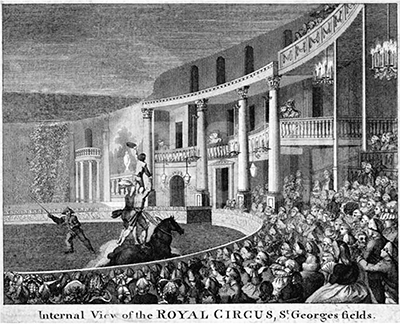 One of Astley's equestrians, Charles Hughes, in partnership with Charles Dibdin, opened the Royal Circus Equestrian and Philharmonic Academy, or Hughes’s Royal Circus. One of Astley's equestrians, Charles Hughes, in partnership with Charles Dibdin, opened the Royal Circus Equestrian and Philharmonic Academy, or Hughes’s Royal Circus. It was a lavish building with a vast stage behind the ring: the model for European Circuses until the end of the 19th century.
|
||||||||||||||||
Because it was so much like a theater, Great Britain's Riot Act of 1714 was read from the stage and Hughes was jailed. Astley was also jailed, but one of his riding students was the daughter of the Lord Chancellor and Astley soon got a license that allowed summer performances as long as only horse acts were featured. Hughes got a license, too: Astley and Hughes became fierce competitors. But the London authorities continued the harassment, so Astley tried Dublin. |
||||||||||||||||||
1783 |
First Paris circus |
Astley opened a circus in Paris, the city that would later celebrate circuses so well. Horse acts only were permitted, so Astley had eight horses carry a platform for acrobats, clowns, and jugglers. All classes of society came. Legend has it that Marie Antoinette presented him with a gold, diamond-encrusted medal and called him the "English Rose." In 1789 Astley had to flee the French Revolution. His arena became a barracks but Napoleon eventually returned it to Astley. |
||||||||||||||||
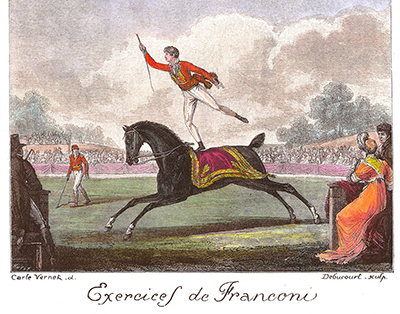 Later an Italian, Franconi, renamed it Cirque Olympique. |
||||||||||||||||||
1793 |
THE FIRST AMERICAN CIRCUS! |
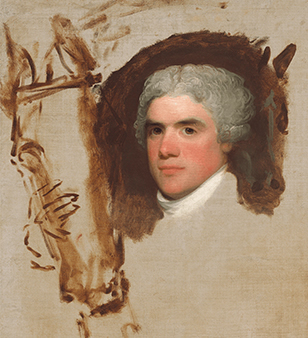 English equestrian John Bill Rickets (from the Hughes circus) tried to open a circus in Edinburg, but the French Revolution put the public out of the mood, so Rickets set sail for America.
Like Astley, he was an army veteran and a skilled rider but also a clever entrepreneur. He started with a simple riding academy in Philadelphia (the then U.S. capitol) in 1792. English equestrian John Bill Rickets (from the Hughes circus) tried to open a circus in Edinburg, but the French Revolution put the public out of the mood, so Rickets set sail for America.
Like Astley, he was an army veteran and a skilled rider but also a clever entrepreneur. He started with a simple riding academy in Philadelphia (the then U.S. capitol) in 1792. By 1793 it was a circus: a roofless 42' ring surrounded by box seats and a standing room "pit." |
||||||||||||||||
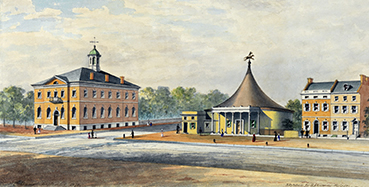 The United States, less than 20 years old, was hungry for entertainment. Rickets soon brought over acts from his old troupe, including an acrobat, a ropedancer, and a clown named McDonald. He also included elements of a sideshow. The United States, less than 20 years old, was hungry for entertainment. Rickets soon brought over acts from his old troupe, including an acrobat, a ropedancer, and a clown named McDonald. He also included elements of a sideshow.
Family entertainment was unusual then, but the show was promoted as in good taste, not scary. New tricks were often added and narrative stories like “Alexander the Great” were frequently changed for repeat visitors. Mrs. Spinacuta, equestrienne/dancer/actress, was a draw. She wore a short dress while standing on a bareback horse. No one admitted it was erotic, but it clearly was. Rickets moved to New York City, and opened much larger circus arenas in Philadelphia, Boston, Quebec, and Montreal. He was overextended. In 1798 his Philadelphia building's dome collapsed. In 1799 his home base in Philly and his New York building both burned down. Rickets was bankrupt. |
||||||||||||||||||
But the seed was planted: other circuses cropped up in America. |
||||||||||||||||||
1796 |
First elephant comes to America |
|
||||||||||||||||
Want to know more about an image? Instructions for looking up images on Google. |
||||||||||||||||||
|
||||||||||||||||||
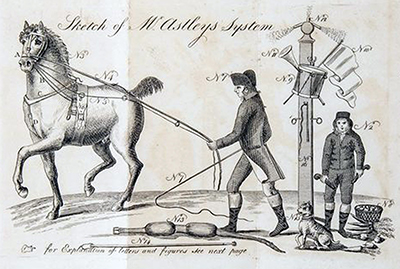 Astley, tall and flamboyant, had instincts for both business and showmanship. In 1768 he opened a riding school near Westminster Bridge in London. He gave lessons in the morning and held demonstrations in the afternoon.
Astley, tall and flamboyant, had instincts for both business and showmanship. In 1768 he opened a riding school near Westminster Bridge in London. He gave lessons in the morning and held demonstrations in the afternoon. .jpg) Each show ended on a light note, with Elizabethan theater's Harlequin, Columbine, or Clown.
Each show ended on a light note, with Elizabethan theater's Harlequin, Columbine, or Clown.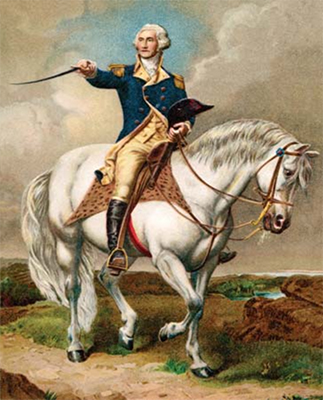 George Washington came often, and he donated the white horse he rode in the revolution to Rickets. At least Rickets claimed it was the same horse.
George Washington came often, and he donated the white horse he rode in the revolution to Rickets. At least Rickets claimed it was the same horse. 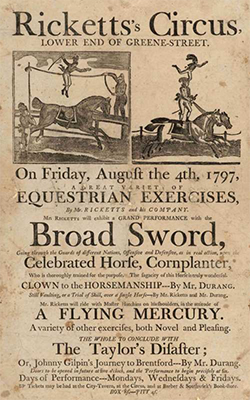
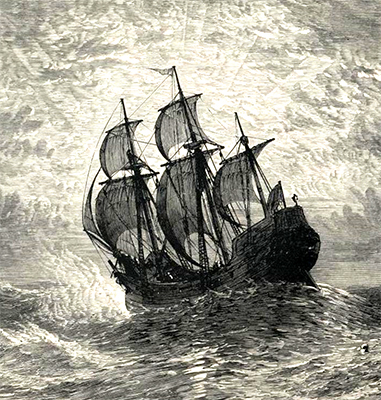 Rickets went to Jamaica where he sold all of his horses. He started to sail home to England, but his ship was captured by pirates, or at any rate lost at sea. He was never seen again.
Rickets went to Jamaica where he sold all of his horses. He started to sail home to England, but his ship was captured by pirates, or at any rate lost at sea. He was never seen again.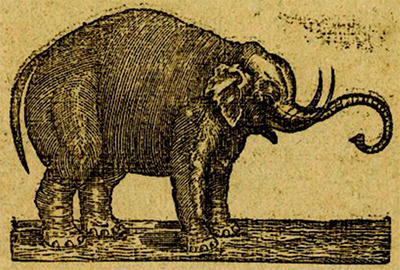 This may have been Old Bet, who was in the menagerie of an early circus owned by a Hachaliah Bailey. People paid 25¢ just to see her. A rogue farmer shot Old Bet: her skin and bones ended up in
This may have been Old Bet, who was in the menagerie of an early circus owned by a Hachaliah Bailey. People paid 25¢ just to see her. A rogue farmer shot Old Bet: her skin and bones ended up in